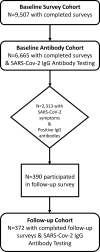Predictors of chronic COVID-19 symptoms in a community-based cohort of adults
- PMID: 35925904
- PMCID: PMC9352033
- DOI: 10.1371/journal.pone.0271310
Predictors of chronic COVID-19 symptoms in a community-based cohort of adults
Abstract
Background: COVID-19 can cause some individuals to experience chronic symptoms. Rates and predictors of chronic COVID-19 symptoms are not fully elucidated.
Objective: To examine occurrence and patterns of post-acute sequelae of SARS-CoV2 infection (PASC) symptomatology and their relationship with demographics, acute COVID-19 symptoms and anti-SARS-CoV-2 IgG antibody responses.
Methods: A multi-stage observational study was performed of adults (≥18 years) from 5 US states. Participants completed two rounds of electronic surveys (May-July 2020; April-May 2021) and underwent testing to anti-SARS-CoV-2 nucleocapsid protein IgG antibody testing. Latent Class Analysis was used to identify clusters of chronic COVID-19 symptoms.
Results: Overall, 390 adults (median [25%ile, 75%ile] age: 42 [31, 54] years) with positive SARS-CoV-2 antibodies completed the follow-up survey; 92 (24.7%) had ≥1 chronic COVID-19 symptom, with 11-month median duration of persistent symptoms (range: 1-12 months). The most common chronic COVID-19 symptoms were fatigue (11.3%), change in smell (9.5%) or taste (5.6%), muscle or joint aches (5.4%) and weakness (4.6%). There were significantly higher proportions of ≥1 persistent COVID-19 symptom (31.5% vs. 18.6%; Chi-square, P = 0.004), and particularly fatigue (15.8% vs. 7.3%, P = 0.008) and headaches (5.4% vs. 1.0%, P = 0.011) in females compared to males. Chronic COVID-19 symptoms were also increased in individuals with ≥6 acute COVID-19 symptoms, Latent class analysis revealed 4 classes of symptoms. Latent class-1 (change of smell and taste) was associated with lower anti-SARS-CoV-2 antibody levels; class-2 and 3 (multiple chronic symptoms) were associated with higher anti-SARS-CoV-2 antibody levels and more severe acute COVID-19 infection.
Limitations: Ambulatory cohort with less severe acute disease.
Conclusion: Individuals with SARS-CoV-2 infection commonly experience chronic symptoms, most commonly fatigue, changes in smell or taste and muscle/joint aches. Female sex, severity of acute COVID-19 infection, and higher anti-SARS-CoV-2 IgG levels were associated with the highest risk of having chronic COVID-19 symptoms.
Conflict of interest statement
The authors have declared that no competing interests exist.
Figures




References
-
- Groff D, Sun A, Ssentongo AE, Ba DM, Parsons N, Poudel GR, et al.. Short-term and Long-term Rates of Postacute Sequelae of SARS-CoV-2 Infection: A Systematic Review. JAMA Netw Open. 2021;4(10):e2128568. Epub 2021/10/14. doi: 10.1001/jamanetworkopen.2021.28568 ; PubMed Central PMCID: PMC8515212. - DOI - PMC - PubMed
Publication types
MeSH terms
Substances
Grants and funding
LinkOut - more resources
Full Text Sources
Medical
Miscellaneous

